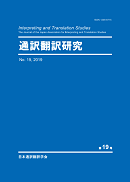Volume 13
Displaying 1-17 of 17 articles from this issue
- |<
- <
- 1
- >
- >|
Articles
-
2013Volume 13 Pages 1-23
Published: 2013
Released on J-STAGE: November 29, 2021
Download PDF (626K) -
2013Volume 13 Pages 25-41
Published: 2013
Released on J-STAGE: November 29, 2021
Download PDF (396K) -
2013Volume 13 Pages 43-62
Published: 2013
Released on J-STAGE: November 29, 2021
Download PDF (649K) -
2013Volume 13 Pages 63-78
Published: 2013
Released on J-STAGE: November 29, 2021
Download PDF (728K)
Research Notes
-
2013Volume 13 Pages 79-95
Published: 2013
Released on J-STAGE: November 29, 2021
Download PDF (566K) -
2013Volume 13 Pages 97-114
Published: 2013
Released on J-STAGE: November 29, 2021
Download PDF (502K)
Reports
-
2013Volume 13 Pages 115-117
Published: 2013
Released on J-STAGE: November 29, 2021
Download PDF (288K)
Essays
-
2013Volume 13 Pages 119-138
Published: 2013
Released on J-STAGE: November 29, 2021
Download PDF (640K) -
2013Volume 13 Pages 139-147
Published: 2013
Released on J-STAGE: November 29, 2021
Download PDF (271K)
Book Reviews
-
2013Volume 13 Pages 148-149
Published: 2013
Released on J-STAGE: November 29, 2021
Download PDF (272K) -
2013Volume 13 Pages 151-152
Published: 2013
Released on J-STAGE: November 29, 2021
Download PDF (284K)
Dissertation Summaries
-
2013Volume 13 Pages 153-156
Published: 2013
Released on J-STAGE: November 29, 2021
Download PDF (366K) -
The Effectiveness of an Interpreting Training Method, “Reproduction,” in University English Teaching2013Volume 13 Pages 157-159
Published: 2013
Released on J-STAGE: November 29, 2021
Download PDF (253K) -
2013Volume 13 Pages 161-164
Published: 2013
Released on J-STAGE: November 29, 2021
Download PDF (252K) -
2013Volume 13 Pages 165-170
Published: 2013
Released on J-STAGE: November 29, 2021
Download PDF (241K) -
2013Volume 13 Pages 171-172
Published: 2013
Released on J-STAGE: November 29, 2021
Download PDF (264K) -
2013Volume 13 Pages 173-174
Published: 2013
Released on J-STAGE: November 29, 2021
Download PDF (292K)
- |<
- <
- 1
- >
- >|
